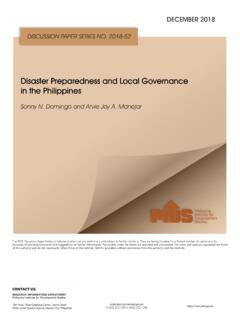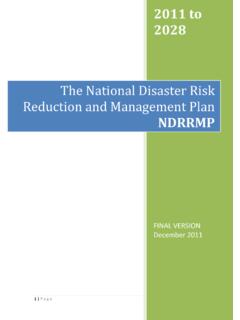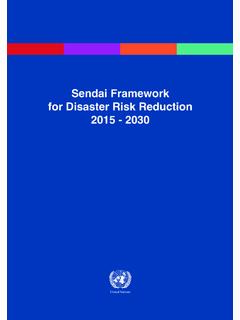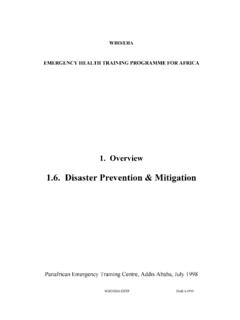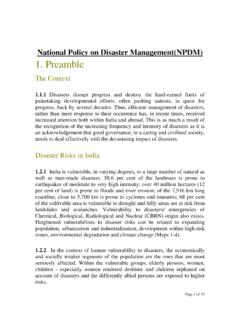Transcription of National Disaster Risk Reduction and Management Plan ...
1 National Disaster Risk Reduction and Management plan (NDRRMP) 2011 2028 EXECUTIVE SUMMARY The National Disaster Risk Reduction and Management plan (NDRRMP) fulfills the requirement of RA No. 10121 of 2010, which provides the legal basis for policies, plans and programs to deal with disasters. The NDRRMP covers four thematic areas, namely, (1) Disaster Prevention and Mitigation; (2) Disaster preparedness ; (3) Disaster Response; and (4) Disaster Rehabilitation and Recovery, which correspond to the structure of the National Disaster Risk Reduction and Management Council (NDRRMC). By law, the Office of Civil Defense formulates and implements the NDRRMP and ensures that the physical framework, social, economic and environmental plans of communities, cities, municipalities and provinces are consistent with such plan .
2 The NDRRMP is consistent with the National Disaster Risk Reduction and Management Framework (NDRRMF), which serves as the principal guide to Disaster risk Reduction and Management (DRRM) efforts to the The Framework envisions a country of safer, adaptive and Disaster -resilient Filipino communities toward sustainable development. It conveys a paradigm shift from reactive to proactive DRRM wherein men and women have increased their awareness and understanding of DRRM, with the end in view of increasing people s resilience and decreasing their vulnerabilities. National Disaster Risk Reduction and Management plan 2011-2028. The NDRRMP sets down the expected outcomes, outputs, key activities, indicators, lead agencies, implementing partners and timelines under each of the four distinct yet mutually reinforcing thematic areas.
3 The goals of each thematic area lead to the attainment of the country s overall DRRM vision, as graphically shown below. Safer, adaptive and Disaster resilient Filipino communities towards sustainable development Disaster Prevention and Mitigation Avoid hazards and mitigate their potential impacts by reducing vulnerabilities and exposure and enhancing capacities of communities Disaster preparedness Establish and strengthen capacities of communities to anticipate, cope and recover from the negative impacts of emergency occurrences and disasters Disaster Response Provide life preservation and meet the basic subsistence needs of affected population based on acceptable standards during or immediately after a Disaster Disaster Rehabilitation and Recovery Restore and improve facilities.
4 Livelihood and living conditions and organizational capacities of affected communities, and reduced Disaster risks in accordance with the building back better principle The NDDRMP goals are to be achieved by 2028 through 14 objectives, 24 outcomes, 56 outputs, and 93 activities. The 24 outcomes, with their respective overall responsible agencies, are summarized below. Thematic Area 1: Disaster Prevention and Mitigation Overall responsible agency: Department of Science and Technology (DOST) Outcome Lead agency(ies) 1. DRRM and CCA mainstreamed and integrated in National , sectoral, regional and local development policies, plans and budget Office of Civil Defense (OCD) 2. DRRM and CCA-sensitive environmental Management Department of Environment and Natural Resources (DENR) 3.
5 Increased resiliency of infrastructure systems Department of Public Works and Highways (DPWH) 4. Enhanced and effective community-based scientific DRRM and CCA assessment, mapping, analysis and monitoring OCD 5. Communities access to effective and applicable Disaster risk financing and insurance Department of Finance (DOF) 6. End-to=end monitoring (monitoring and response), forecasting and early warning systems are established and/or improved Department of Science and Technology (DOST) Thematic Area 2: Disaster preparedness Overall responsible agency: Department of Interior and local Government (DILG) Outcome Lead agency(ies) 7. Increased level of awareness and enhanced capacity of the community to the threats and impacts of all hazards Philippine Information Agency (PIA) 8.
6 Communities are equipped with necessary skills and capability to cope with the impacts of disasters Department of Interior and local Government (to coordinate) and OCD (to implement) 9. Increased DRRM and CCA capacity of local DRRM Councils,Offices and Operation Centers at all levels DILG 10. Developed and implemented comprehensive National and local preparedness and response policies, plans, and systems DILG and OCD 11. Strengthened partnership and coordination among all key players and stakeholders DILG Thematic Area 3: Disaster Response Overall responsible agency: Department of Social Welfare and Development (DSWD) Outcome Lead agency(ies) 12. Well-established Disaster response operations Department of Social Welfare and Development (DSWD) 13.
7 Adequate and prompt assessment of needs and damages at all levels Disaster Risk Reduction and Management Councils (DRRMCs), OCD and DSWD 14. Integrated and coordinated Search, Rescue and Retrieval (SRR) capacity Department of National Defense (DND), DILG, Department of Health (DOH) 15. Safe and timely evacuation of affected communities local government units (LGUs) 16. Temporary shelter needs adequately addressed DSWD 17. Basic social services provided to affected population (whether inside or outside evacuation centers) DOH 18. Psychosocial needs of directly and indirectly affected population addressed DOH 19. Coordinated, integrated system for early recovery implemented DSWD Thematic Area 4: Disaster Rehabilitation and Recovery Overall responsible agency: National Economic and Development Authority (NEDA) Outcome Lead agency(ies) 20.
8 Damages, losses and needs assessed OCD 21. Economic activities restored, and if possible strengthened or expanded Agency to be determined based on the affected sectors 22. Houses rebuilt or repaired to be more resilient to hazard events; safer sites for housing National Housing Authority (NHA) 23. Disaster and climate change-resilient infrastructure constructed/reconstructed DPWH 24. A psychologically sound, safe and secure citizenry that is protected from the effects of disasters is able to restore to normal functioning after each Disaster DOH and DSWD The NDRRMP is a road map on how DRRM shall contribute to gender-responsive and rights-based sustainable development.
9 Highlights include: The need for institutionalizing DRRM policies, structures, coordination mechanisms and programs with continuing budget appropriation on DRR from National down to local levels. Thus, several activities will strengthen the capacity of the personnel of National government and the local government units (LGUs) and partner stakeholders, build the Disaster resilience of communities and institutionalize arrangements and measures for reducing Disaster risks , including climate risks . The importance of mainstreaming DRRM and CCA in the development processes such as policy formulation, socio-econoimc development planning, budgeting and governance, particularly in the area of environment, agriculture, water, energy, health, education, poverty Reduction , land-use and urban planning and public infrastructure and housing, among others.
10 This is achieved through activities such as development of common tools to analyze the various hazards and vulnerability factors which put communities and people in harms way. Competency and science-based capacity building activities alongside the nurturing of continuous learning through knowledge development and Management of good DRRM practices on the ground. The inclusion of human-induced disasters that result in internally displaced persons, public anxiety, loss of lives, destruction of property and sometimes socio-political stability. Encompassing conflict resolution approaches, the plan seeks to mainstream DRRM into the peace process.










